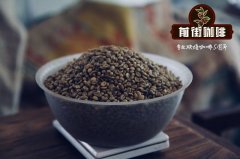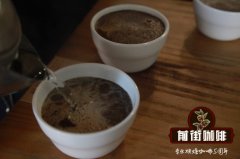The growth environment requirements of Ethiopian coffee beans and the shape of coffee beans are long beans and small round beans.

Professional coffee knowledge exchange more coffee bean information please follow the coffee workshop (Wechat official account cafe_style)
Although the Ethiopian Yirgacheffe coffee is petite, it is gentle and delicate and sweet. As the hometown of coffee, thousands of years of planting history and processing tradition in Ethiopia have created high-quality washed Arabica beans. Light baking has unique sweet aromas of lemon, flowers and honey, soft acidity and citrus flavors, fresh and bright on the palate. No milk or sugar, let the rich texture and unique soft flower scent brush your taste buds, leaving an endless aftertaste.
Yega Xuefei is a small town, 700-2100 meters above sea level, synonymous with Ethiopian boutique coffee. It has been a wetland since ancient times. The ancient saying "Yirga" means "settle down" and "Cheffe" means "wetland". The mode of production and flavor of coffee here is so outstanding that Ethiopian coffee farmers compete to be proud of the flavor of their coffee, making it the most famous coffee producing area in Africa.
Ethiopia is the birthplace of the famous Arabica coffee beans, of all the producing areas, Hidamo and Yegashafi are the most outstanding, and people have always maintained the tradition of harvesting wild coffee beans. The coffee garden with an elevation of more than 1500 meters has formed a unique coffee style after thousands of years of evolution and adaptation. Ethiopian coffee is mostly washed beans, full-bodied flowers, smooth and subtle, as well as strong chocolate and fruit aromas.
Ethiopian coffee, which grows in the natural wild environment, is called "wilderness coffee". It retains the most primitive and natural taste of coffee beans and has the most direct and full expression of the soil. Because of its rich and complex fruit aroma, it has become an international hit almost overnight, becoming a hot target for experts and expensive.
Long-grain beans:
It is planted all over Ethiopia, and from the actual proportion seen, there are more long grain varieties in western Jimma, including Limmu and Kaffa, and less in sidama (Sidamo) or yirgacheffe (Yega Sheffield).
Small beans:
The shape of the bean is relatively round and the bean body is small, mostly between 14 and 15 mesh. They can often be seen in Sidamo and Yegashifi. Compared with other regions, sidama, yigracheffe and surrounding arsi, guji have more native varieties of these small particles.
In addition to the diversity of varieties, the cultivation of coffee has also affected the complexity of Ethiopian beans. Ethiopia's coffee cultivation is divided into:
● forest coffee forest coffee (8-10%), coffee trees and other crops coexist in the primeval forest, without any artificial care, farmers will pick coffee fruits regularly.
END
Important Notice :
前街咖啡 FrontStreet Coffee has moved to new addredd:
FrontStreet Coffee Address: 315,Donghua East Road,GuangZhou
Tel:020 38364473
- Prev

In the process of making latte, is the milk foam as thin as possible, the better, the lower the moisture, the better?
Professional coffee knowledge exchange more coffee bean information please pay attention to the coffee workshop (Wechat official account cafe_style) the fineness of the foam and your feel is directly related to the choice of milk, the lower the milk moisture, the better, the most used is Nestle whole milk. When foaming, first open the steam stick for a while, let out the liquid water inside, and put the nozzle into the noodle.
- Next

Ethiopian Coffee Bean Story Ethiopian Coffee Bean and Kenyan Coffee Bean Features Story
Professional coffee knowledge exchange More coffee bean information Please pay attention to coffee workshop (Weixin Official Accounts cafe_style) Ye Jia Xuefei, known for its fresh and bright taste and rich floral and fruity flavor. The washed Yerga Sherfie has the signature citrus lemon blossom and a taste of black tea. Even if it is a small partner who is initially exposed to single-item coffee, it can obviously feel its speed.
Related
- Detailed explanation of Jadeite planting Land in Panamanian Jadeite Manor introduction to the grading system of Jadeite competitive bidding, Red bid, Green bid and Rose Summer
- Story of Coffee planting in Brenka region of Costa Rica Stonehenge Manor anaerobic heavy honey treatment of flavor mouth
- What's on the barrel of Blue Mountain Coffee beans?
- Can American coffee also pull flowers? How to use hot American style to pull out a good-looking pattern?
- Can you make a cold extract with coffee beans? What is the right proportion for cold-extracted coffee formula?
- Indonesian PWN Gold Mandrine Coffee Origin Features Flavor How to Chong? Mandolin coffee is American.
- A brief introduction to the flavor characteristics of Brazilian yellow bourbon coffee beans
- What is the effect of different water quality on the flavor of cold-extracted coffee? What kind of water is best for brewing coffee?
- Why do you think of Rose Summer whenever you mention Panamanian coffee?
- Introduction to the characteristics of authentic blue mountain coffee bean producing areas? What is the CIB Coffee Authority in Jamaica?

